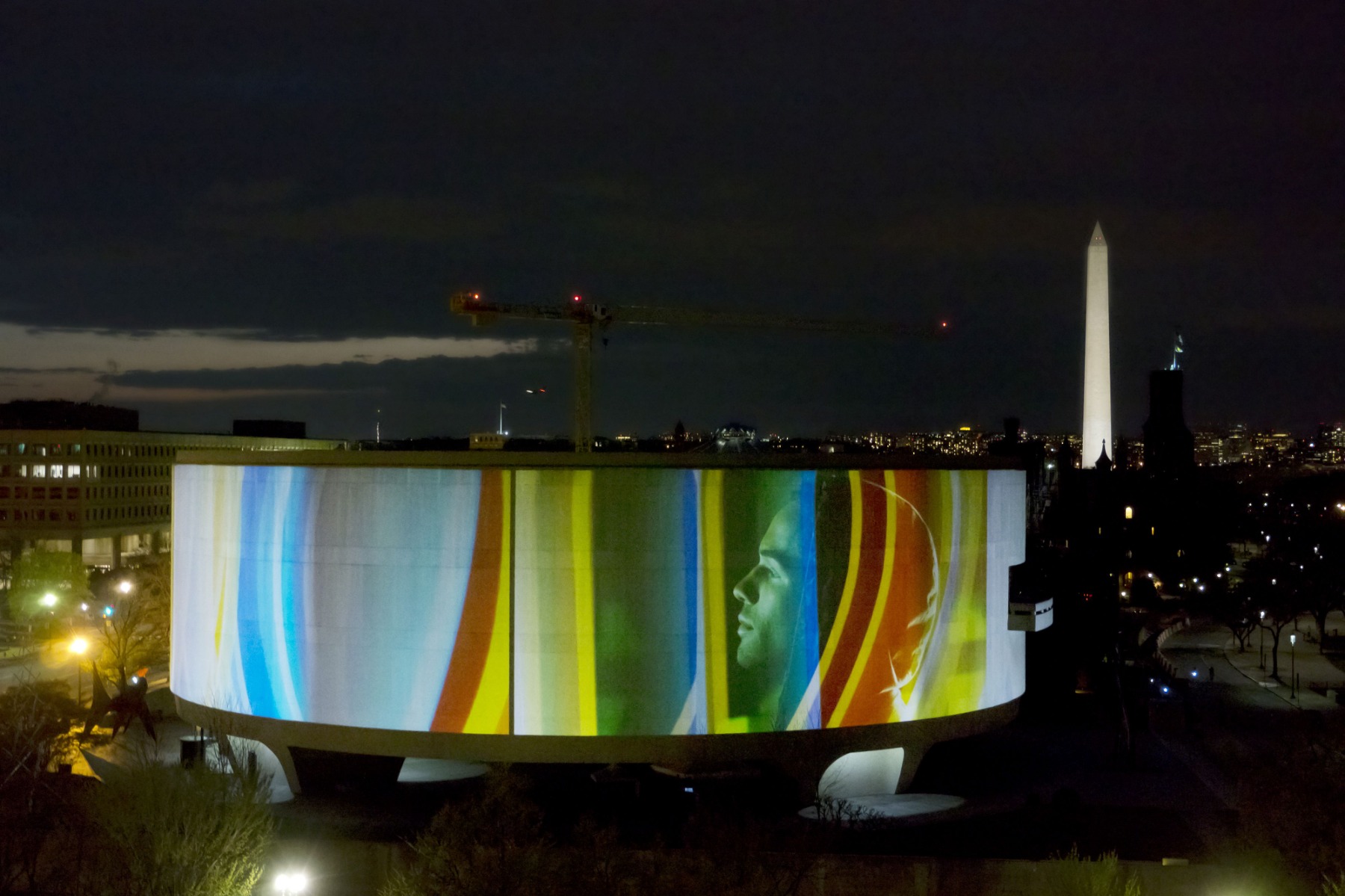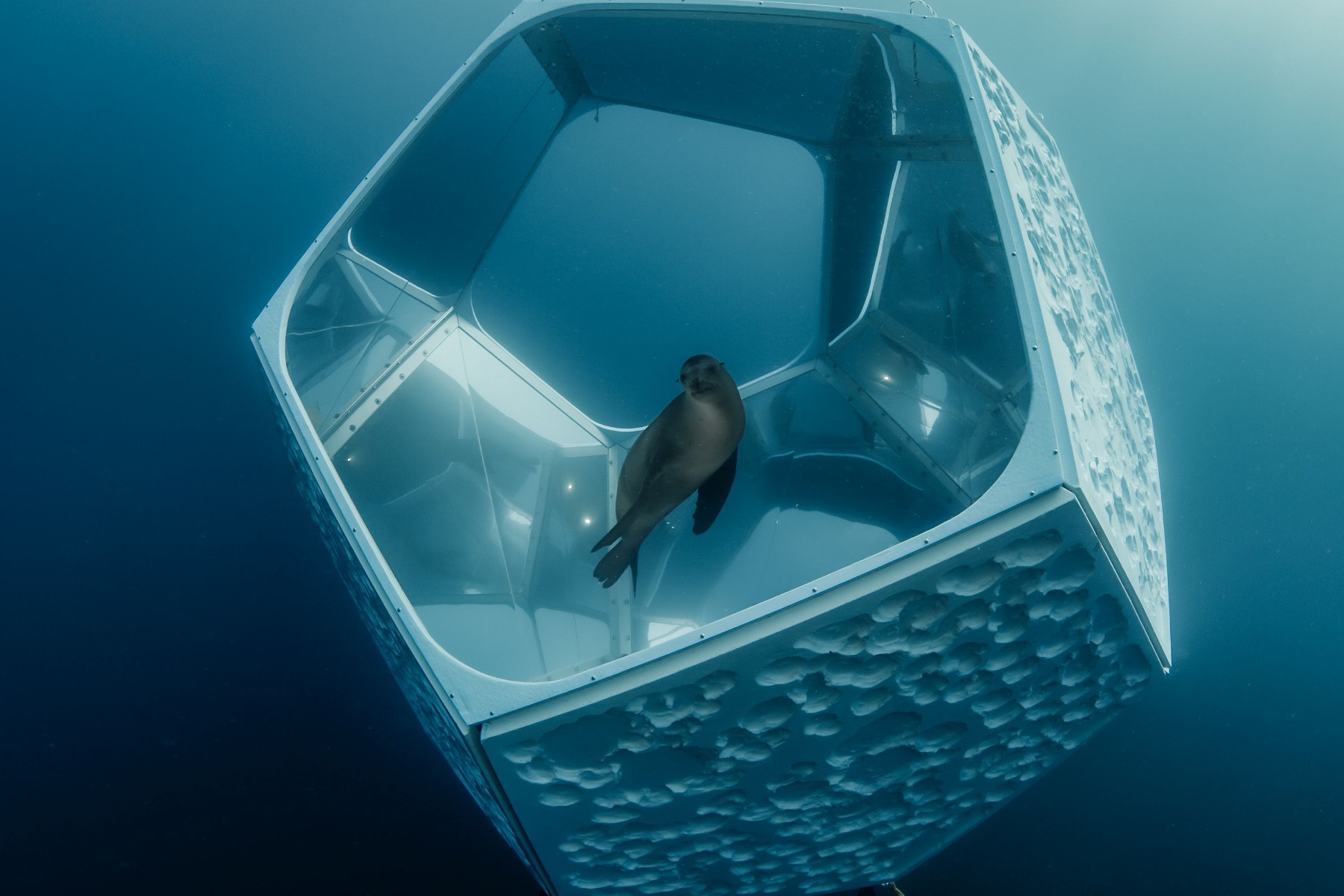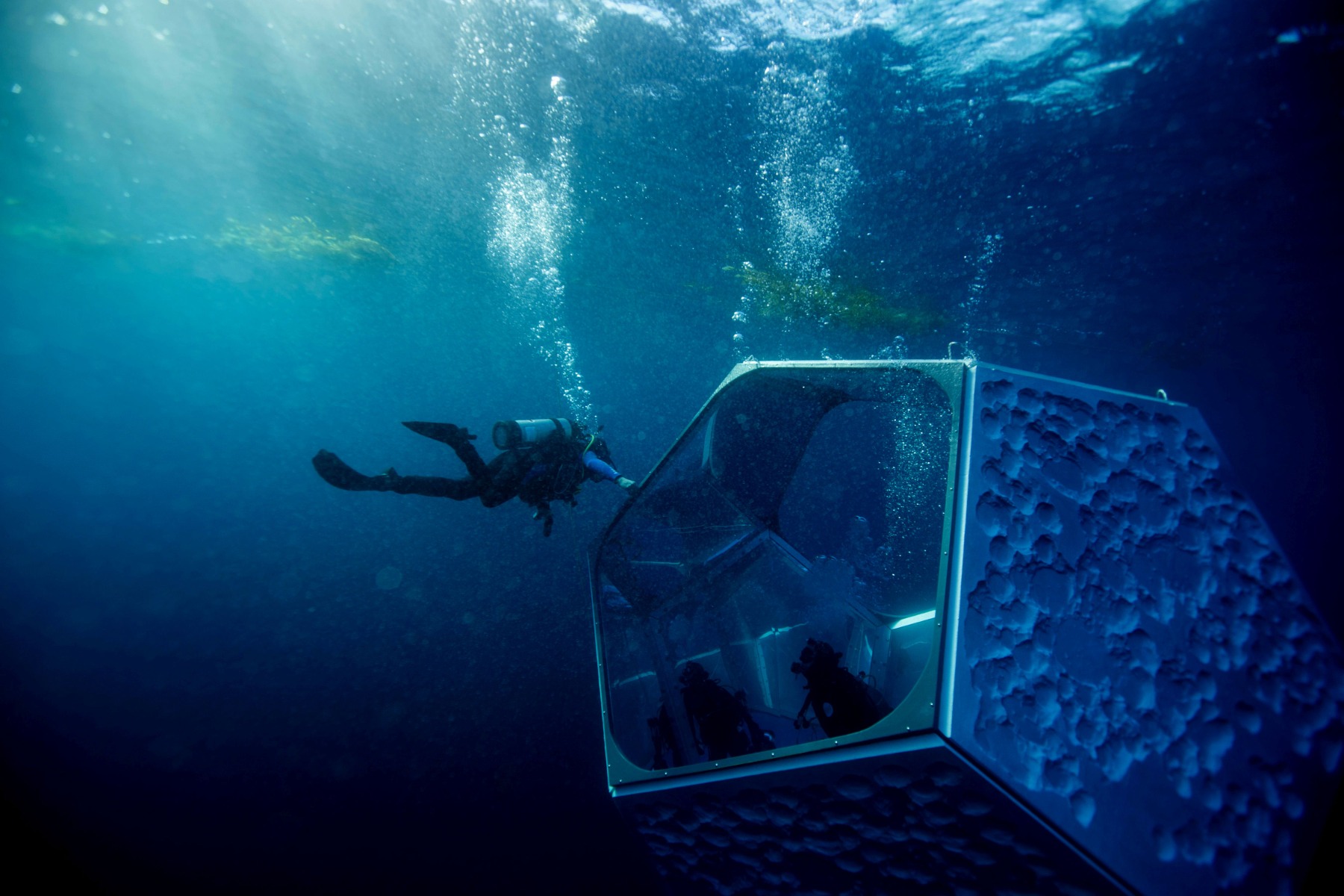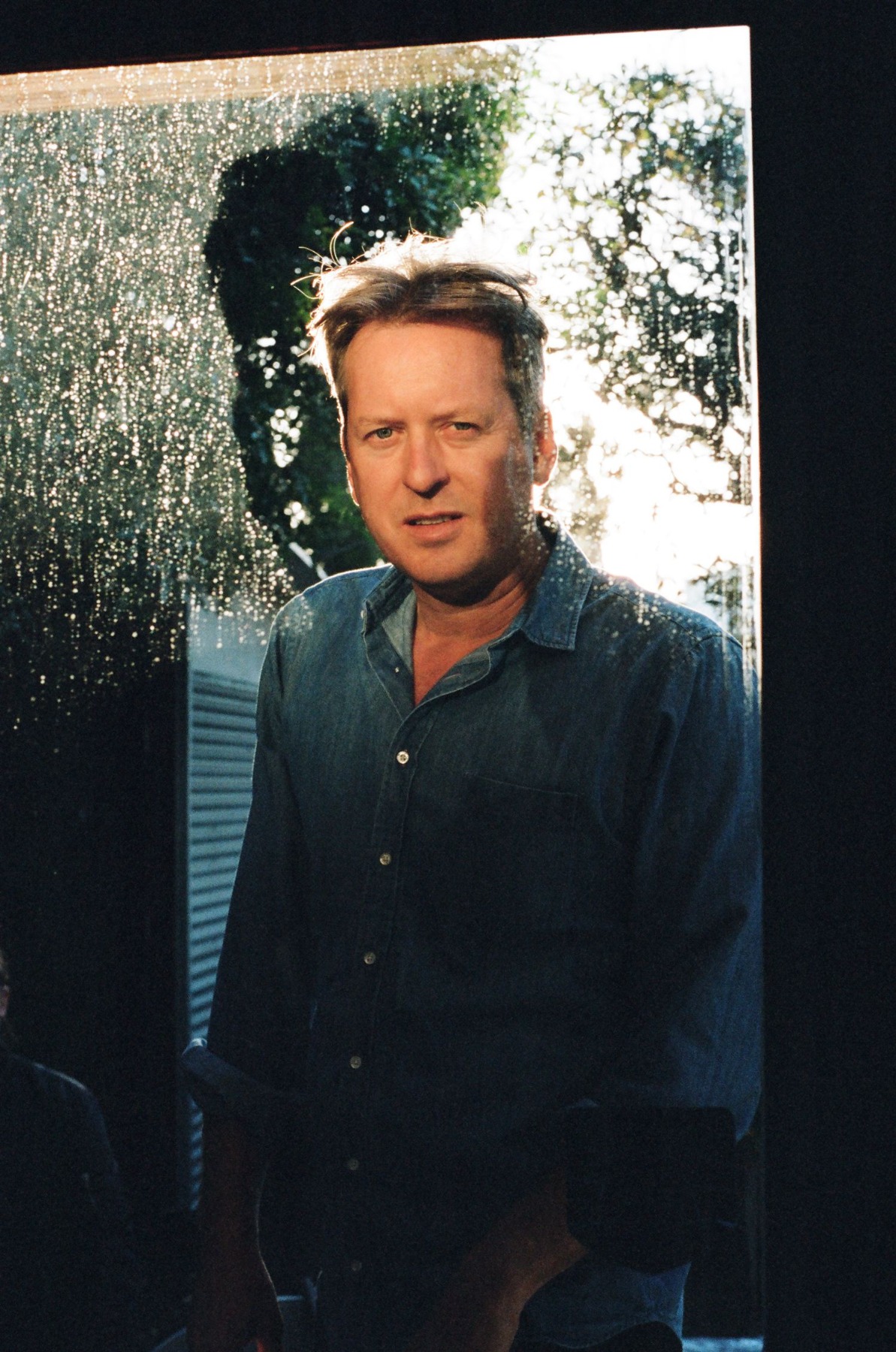
Artwork has power – it has mystery, it is an enigma
An interview with Doug Aitken
‘I think it's interesting that we associate art with museums and galleries. Is this the only place where you're supposed to see art? We should be opening up the world around us – the urban spaces, the sky, the ocean, the mountains and forest, the desert… Any place has the possibility to share an artwork, to be activated in a different way’, says artist Doug Aitken, who has realised many of his projects beyond the walls of a traditional spaces relegated to art.
Two noteworthy examples: in 2016 Underwater Pavilions was installed off the coast of Catalina Island, becoming a Wunderkammer of sorts for swimmers and divers – a point of interest that serves as an extension of experience and reality; and in 2017, his environmental object Mirage – created during the first Desert X Biennial in Coachella Valley – endlessly replicated the environment in its mirrored walls, completely breaking the boundaries between architecture and the environment, between reality and the projection of reality.
Then there are Aitken's interventions in urban environments in which he effectively changes a landmark’s conventional image – a projection of eyes onto Vienna’s Secession Building visible each evening after as the museum closed for the day (Glass Horizon, 1998), or the transformation of the facade of the Hirshhorn Museum (SONG 1, 2012-2015). These installations engage his interest in the concept of ‘liquid architecture’. He explains the term as ‘although architecture has traditionally been defined by form and structure, there are other perceptual levels that can create a sense of form and structure, and those forms do not need to be solid. They do not need to be concrete and glass, rather they could be sound, light, different areas of perception or even temperature.’
Doug Aitken. SONG 1. 2012. Outdoor video installation on 360-degree facade of Hirshhorn Museum and Sculpture Garden, Smithsonian Institution, Washington, DC, seven-channel composite video (color, sound), eleven projections forming one screen. 34:44 minutes/loop. Installation dimensions variable; Screen: 50 x 725 feet circumference (15.2 x 220.9 m circumference). Photo by Brian Doyle
SONG 1, which can be seen through 10 January at Doug Aitken’s solo show at Kiasma in Helsinki, is structured around the song ‘I Only Have Eyes for You’, a pop standard written in 1934 that melds an ultraminimal statement of desire and dedication with an unforgettable melody. In order to emphasise the universality of the song, dozens of versions were specially created for SONG 1 by a stylistically diverse group of musicians. When asked how, five years after its debut in Washington, the work fits into today’s context, Aitken informs me that ‘the work is actually more relevant today than when I made it.’
You once said that you think it's very interesting how we see ourselves in this landscape that we have created. Over the last year the world has dramatically changed, and our belief in human power has been dismissed. We use technologies and screens more than ever before, but we have also come to understand that a screen doesn't allow for intimacy – it doesn't allow for the flow of energy between two human beings. Coming back to your rhetorical observation – how do you see humans in the landscape of today? Where do you think we are we heading?
I think what we’re experiencing these last eight months is quite unlike anything in human history. It is a moment in which is not only a global crisis in terms of Covid, but in terms of all the other ripple effects. I think it's a transitional moment. We find ourselves in a situation where we are no longer able to follow routines. Much of human activity is based on repetition; you wake up, work, return, go to bed. In this period, all of that is disrupted and we find ourselves looking at screens; we find ourselves isolated. We find ourselves spending more time in the digital world but also yearning for a natural experience even more. The extremes of a spectrum are activated, but the middle, a normal sense of the past, have disappeared. This is a very, important time because each and every one of us, every individual, has a voice. I think now is the time to use it for creativity – to express, to communicate, to create worlds that don't exist, the value of creativity and culture now is more salient than it has ever been.
The main installation on view at Kiasma, SONG 1, was created five years ago. How does it fit within today’s context?
Art doesn't act alone, it only acts in response to a viewer. There's a dialogue and relationship with the viewer. While the viewer projects some of themselves onto the artwork, the artwork reflects back a vision of and to the viewer. The artwork on view at Kiasma interacts like that. The work is very different when you look at it now compared to when I initially created it, even more relevant today than it was when I made it. I think the idea is really about this kind of ‘tapestry of humanity’ – the kind of randomness of life, the idea that you can follow one person to another. What if you could follow all the narratives, all the different stories of the individuals that you see? That speaks to me right now because we find ourselves kind of reaching out for connectivity. We want relationships and humanity. We want to have a discussion with someone, because it's not easy – it’s something that we have to struggle for. And I think the work expresses that very much.
Kiasma is a museum that is open, with limited access, where you can go inside the space and you can lie down on the floor and immerse yourself in an artwork. We are collectively starved not being able to experience culture aso I'm incredibly grateful that this work is on view, that this exhibition is open in Finland, and people can see it and share it.
Doug Aitken - Song 1 Installation 2012 from Doug Aitken Workshop on Vimeo.
The audience, people’s reactions, have always been very important to you. Very often the viewer becomes a part of your art pieces, even to the extent of being an ‘actor’ who is taking part in your installations:
I think that's very true. With this exhibition at Kiasma, each person experiences it a different way. You may see it very differently than the person who is behind you or the person who is to your side. I like that idea that artworks do not need to be linear and that they don't need to have a singular meaning, instead they can activate and inspire.
Doug Aitken. SONG 1, 2015. Video installation with seven-channel composite video (color, sound), seven blended projections, 360-degree aluminum and PVC screen; Installation view at Museum of Contemporary Art, Los Angeles; Courtesy of the Artist, 303 Gallery, New York; Galerie Eva Presenhuber, Zürich; Victoria Miro Gallery, London; and Regen Projects, Los Angeles; Photo by Dakota Higgins
Speaking about the birth of ideas and inspiration, there’s a growing call for something along the lines of ‘a new Bauhaus school’ – a movement that unites creative minds and promotes synergistic work between philosophers, scientists, artists, etc. – a new force that could be truly impactful in helping to create a positive future for humanity. Cooperation with different disciplines is one of the pillars of your creative process, and you involve people from many different cultural scenes and branches of knowledge in your projects. SONG 1, on view at Kiasma right now, is just one example; there’s also Station to Station, Underwater Pavilions, Diamond Sea, and other works of yours that indicate a high level of multi-disciplinary collaboration.
I think you're absolutely right in describing it like that. I think that if we do look forward, if we project what may happen in the future and what we desire to happen in the future, we see that we want to live in a world with less siloing, with less separation. I think that creativity should be seen as a living organism. An ecology of ideas that are shifting and taking different forms and shapes. To me, that is the zenith – an absolute high point of what culture can be. It's amazing that there are so many different mediums that people can work in, and when they start to cross over, it becomes very interesting, and unexpected things can happen. I think that's part of the beauty of what you're talking about – this enormous potential that arises when you see different disciplines cross over and create friction and energy.
You use a wide range of mediums – from video installations to architectural interventions. As you said, you step in and out according to the idea of the artwork. Everything new in art history arose from the desire to experiment. How important to you is this challenge to experiment, the desire to find something new?
I think the challenge is what attracts you to making projects. If you know how to make something well and you continue only making that - all you’re doing is refining it. Personally, I don't see much possibility for discovery in that. If you have an idea and you take it to a territory that is less familiar that's the area where there's more potential and room for discovery. I think that we should see culture as an area for discovery. We should see it as a space in which to stretch our philosophy as a culture – to stretch our idea of ourselves and the world around us.
You use the latest technologies in your artwork. Is that deliberate, or just a means to the end?
Technology can only really exist in service of the idea. The idea and the concept must come first, and the concept will dictate what medium you use and how you use it – whether a watercolour or a film, an installation or a happening. The idea is the most important starting point and then it can dictate what medium to choose.
Some say that artificial intelligence is already present in the world. What does that mean for us? What does it mean for art? Can, or will, AI replace the artist in the creation process?
That’s an interesting question and I'm not sure if I have an answer. Art can be many things. Art can be anything, if you subscribe to Joseph Beuys and his approach. For myself, the art that I value most is where there is something familiar yet also something completely different and unexpected, and when there's something disruptive and even unpredictable. I think that idea of disruption, of unpredictability is in opposition to artificial intelligence, which is more about patterning and predicting, to foreshadow what a viewer might want. One of the great values of art and culture is that it is still a space where an individual can have a voice and a vision that can be so extreme that it cannot be replicated.
There is an opinion that, in some ways, an artist is like a shaman who can help people find the right path, and/or change their point of view. Do you agree with that? Do you believe that art has the power to change the world in some way?
I think that art can play a very valuable role. The idea of the artist as a shaman is a mythological, romantic vision. I do think that a great artwork has the capacity of have the power, mystery and enigma to become part of you. It becomes a part of your perspective in life, part of your questioning. It's one of the major factors that separates us as humans from the animal world. The idea that we are attracted to abstraction, to things that are esoteric, things that cannot be realised or do not have specific conclusions – these are part of what makes us as people so incredibly special. I think that's what's so important about culture. It's not didactic.
Doug Aitken - MIRAGE from Doug Aitken Workshop on Vimeo.
You’ve said that you don't separate life from art. Could you tell me about your home in California, which appears to be a confirmation of that statement? It seems that you are, in fact, living in your own artwork.
The house I live is more an installation. In building this I realised that all of these very ordinary decisions that you make, you need a table, walls, you a door – those decisions could become ideas. I designed the house in a way that it could come to life. It can be turned on and can amplify the sound of the earth. The tables can be played like musical instruments and the light shines through the house creating different colours and patterns. I wanted an activated space, it was a personal project, but it is became something that inspired subsequent project.
Doug Aitken. Mirage, 2017. Acrylic mirrors, steel, plywood; Installation view at Desert X, Palm Springs. Courtesy of the Artist and Desert X. Photo by Doug Aitken Workshop

Architecture is one of your instruments. You often use the term ‘liquid architecture’.
‘Liquid architecture’ is the idea that although architecture has traditionally been defined by form and structure, I think that there are other perceptual levels that can also create a sense of form and structure, and that those forms do not need to be solid. They don't need to be concrete and glass. They could be sound, they could be light, they could be different areas of perception, like temperature. All of these things can create a sense of structure. And I think that's a very important territory for us to look at.
My house is a very relevant place right now. Earlier in our conversation we were talking about how these last eight months with Covid have been different. Perhaps one of the reasons it's different is because we’ve all been forced to slow down and remain in our home to reflect on how we live, the world we live in, what we've created, what we want to do, what we have done.
This is a also very important moment on an ecological level. We’ve suddenly stopped, that allows us to question things. How we live and how we build our cities and how we act as individuals, how we act politically. I feel strangely optimistic about this time because I think that the acceleration of the late 20th and early 21st centuries was so rapid that we never had a moment to pause.
This moment that we're in right now – whether it lasts for six months or a year and a half, who knows – is incredibly valuable because it allows us to consider what is worth, what is value – really? Is value speed and acceleration, or is value synergising with the world around you and the landscape around you? Is value culture and creating, or is value only capitalism and objects? These questions are for everybody. I think the idea that we have a moment of global awareness, of reflection, is absolutely unlike anything that I've seen in history.
Doug Aitken. Underwater Pavilions, 2016, installation view, Avalon, California. Courtesy of the Artist, Parley for the Oceans and MOCA, Los Angeles. Photo by: Patrick T Fallon
Could one say that your artworks provide a kind of opportunity to escape reality?
Rather than escaping reality, I try to present new possibilities for reality, or alternate possibilities. The Underwater Pavilions, in the ocean where it's cold; there's fish swimming by and you're vulnerable. It's not a static picture on the wall. It suddenly pushes you into a reality that is so vivid, so tactile, that it's undeniable – but it's also very hallucinatory.
Doug Aitken, Underwater Pavilions, 2016, installation view, Avalon, California. Courtesy of the Artist, Parley for the Oceans and MOCA, Los Angeles. Photo by: Shawn Heinrichs
I think it's interesting that we often only associate art with museums and galleries. Is this the only place where you're supposed to see art? I think people want to live in a world where art is open for discussion and there's room for exploration and discovery. An artwork can become a key component in that activation of the discovery of self, the discovery of land and of the world around us.
DOUG AITKEN - UNDERWATER PAVILIONS from Doug Aitken Workshop on Vimeo.
Realising your ideas for artworks is a time-consuming process that sometimes may take even years.
Yes. Some of these works take a long time to make but one has to surrender to that. If an idea is necessary, it has to happen. You've got to do what it takes to make it. Sometimes it's very difficult, sometimes there are many obstacles. I think if you acknowledge that when you begin, say a project appears to be completely impossible, but we're going to find a way to make it work. It makes you tackle the idea, figuring it out is part of the process. I think that everybody has different ways of making projects. For myself, I surrender to the fact that some projects will take a long time to complete, but I'm willing to do that.
Doug Aitken. Photo by Ami Sioux